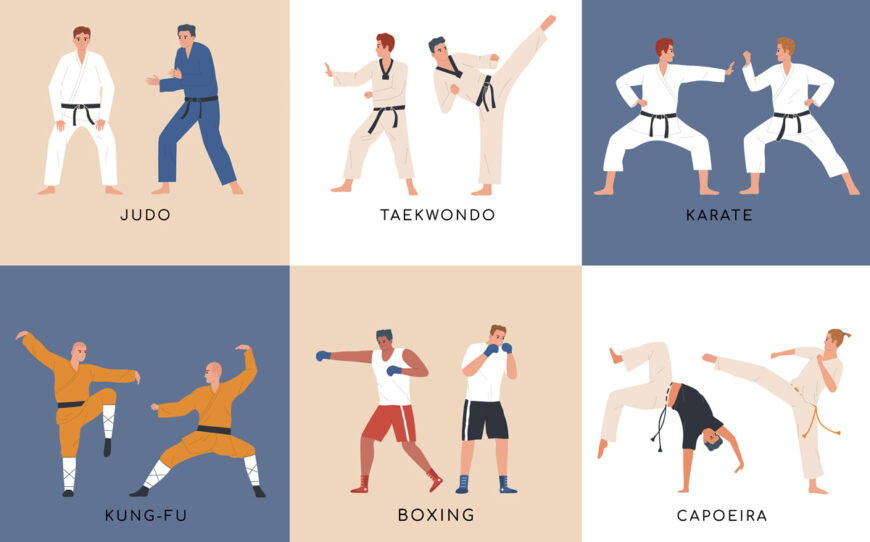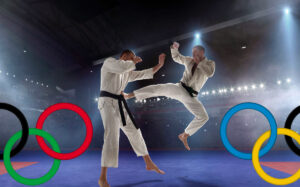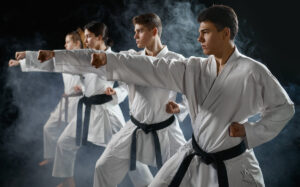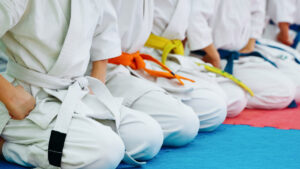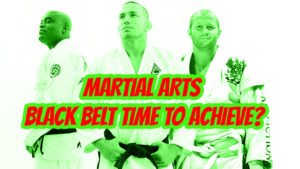Welcome to a world where every punch, kick, and stance tells a story – welcome to the diverse and captivating universe of martial arts. As a fellow enthusiast who has tread the paths of dojos around the world, I understand the blend of excitement and uncertainty that comes with choosing the right martial art. This guide is not just a collection of facts; it’s a window into the soul of over 180 martial arts styles, each with its unique rhythm and heartbeat.
Here, you will not just read about martial arts; you’ll feel the fiery spirit of Muay Thai from Thailand, the disciplined elegance of Korean Taekwondo, and the tranquil flow of Chinese Tai Chi. We’ll journey together through various disciplines:
- Muay Thai: Feel the strength and resilience in every strike.
- Taekwondo: Discover the harmony of swift kicks and inner discipline.
- Tai Chi: Embrace the tranquility and balance in its slow movements.
- Kickboxing: Experience the adrenaline rush of agile and rapid strikes.
- Karate: Learn the power of controlled movements and precision.
- Kung Fu: Dive into the diversity of styles that form this ancient art.
- Aikido: Understand the art of peace and energy redirection.
- Judo: Grasp the technique of throws and ground-based strategies.
- Kendo: Step into a world of discipline and mental focus with bamboo swords.
- Krav Maga: Equip yourself with practical self-defense skills for real-life scenarios.
- Wing Chun: Master the art of close-range combat with rapid-fire strikes.
- Jeet Kune Do: Explore Bruce Lee’s philosophy of efficiency in motion.
- Hapkido: Learn to harness and redirect the energy of your opponents.
- Capoeira: Immerse yourself in the rhythmic blend of fight, dance, and music.
- Brazilian Jiu-Jitsu: Delve into the world of ground grappling and submission techniques.
- Jiu-Jitsu: Experience the traditional Japanese art of grappling and submission.
- Ninjutsu: Discover the ancient Japanese art that combines stealth, tactics, and discipline, originally practiced by the famed ninja warriors.
- Escrima: Engage with the dynamic and rhythmic Filipino martial art known for its use of sticks, knives, and improvised weapons for self-defense.
This guide is your companion on a journey to find not just a martial art, but a part of yourself. It’s about the thrill of learning, the joy of movement, and the journey towards self-mastery. Whether you’re seeking physical fitness, mental discipline, or a deeper cultural connection, let’s embark on this journey together and discover the martial art that resonates with your heart and soul.
Understanding Martial Arts
Martial arts are fighting styles from around the world. Each style trains people to fight or defend themselves. Some martial arts use strikes with fists, elbows, knees, and shins like Muay Thai.
Tai Chi helps find inner peace by using slow movements. Other styles stress fast moves and powerful kicks such as Taekwondo.
Anyone can learn martial arts to get fit or for self-defense. These training techniques help with balance, speed, strength and mental focus too! From Japan’s Karate to China’s Kung Fu, each practice has its own set of rules and techniques.
Various Types of Martial Arts
There are numerous types of martial arts, including Muay Thai, Taekwondo, Tai Chi, Kickboxing, Karate, Kung Fu, Aikido, Judo, Kendo, Krav Maga, Wing Chun, Jeet Kune Do, Hapkido, Capoeira, Brazilian Jiu-Jitsu, Ninjutsu, and Escrima.
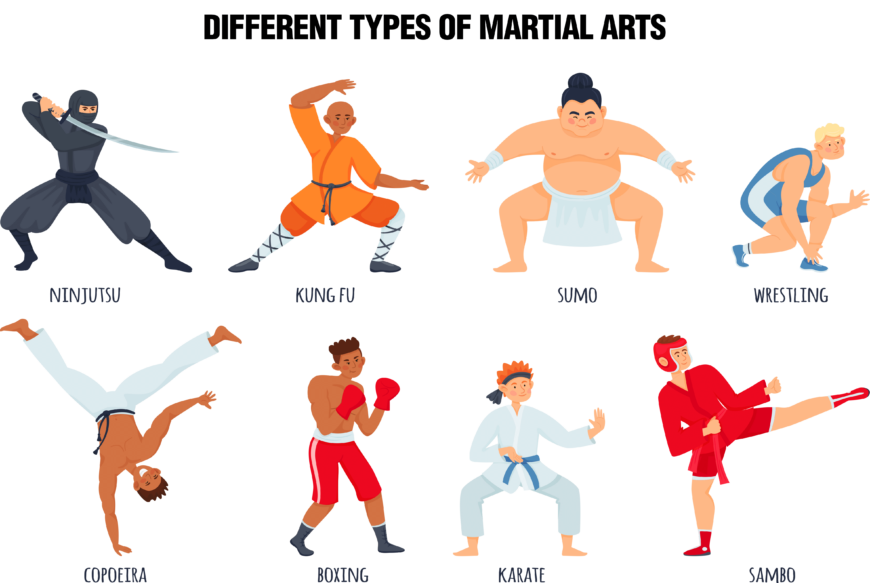
1. Muay Thai
- Dynamic and Versatile: Known as the “Art of 8 Limbs” for its use of various body parts in combat.
- Culturally Rich: Deeply embedded in Thai culture with roots tracing back to ancient Siamese warriors.
- Physically and Mentally Challenging: Emphasizes endurance, power, and mental resilience through rigorous training.
Originating in Thailand, Muay Thai, often referred to as Thai Boxing, is a powerful martial art and combat sport recognized for its dynamic use of fists, elbows, knees, and shins. Historically rooted in the techniques of Siamese warriors on the battlefield, it has evolved from a necessity for close-quarters combat and self-defense into a globally respected sport and a key component of Thai culture.
Muay Thai fighters display a blend of strength, speed, agility, and tactical brilliance in the ring. Their aggressive and intense fighting style is complemented by clinch holds and devastating clinch techniques. Training in Muay Thai is demanding, aiming to foster endurance, power, precision, and mental resilience, making it a captivating discipline for enthusiasts worldwide.
2. Taekwondo
- Historically Rich: Evolved from traditional Korean fighting styles with a history dating back to 37 BC.
- High Energy and Athletic: Known for its high kicks and rapid strikes, paralleling the intensity of kickboxing.
- Values-Driven Training: Emphasizes self-discipline, respect, and mental strength.
Taekwondo, originating from Korea, is a vibrant and fast-paced martial art with roots in traditional Korean styles like Taekkyeon and Subak. It’s renowned for its high and rapid kicks and meticulous hand techniques, gaining worldwide admiration. Evolving in the 1940s and 50s, post the Japanese occupation of Korea, Taekwondo is exhilarating and action-packed.
While sharing similarities with Karate, Taekwondo is unique with its iconic high-kicking methods. Training fosters values like self-discipline, respect, and mental strength. It covers self-defense, forms, sparring, and board-breaking techniques, presenting a harmonious blend of beauty, athleticism, and practicality.
3. Tai Chi
- Philosophically Grounded: Rooted in Taoist principles, focusing on harmony and balance.
- Fluid and Graceful Movements: Emphasizes slow, interconnected sequences that enhance physical and mental health.
- More Than Just Martial Art: A reflection of Chinese culture and a practice for cultivating internal energy and promoting health.
Origins from China, Tai Chi is steeped in Taoist philosophy, striving for a harmonious balance between body, mind, and spirit. Its historical accuracy may be debated, but its essence has been consistent across generations. Characterized by slow, graceful, and fluid movements, Tai Chi promotes relaxation, balance, and inner harmony.
These sequences, performed continuously, cultivate internal energy and physical health. The emphasis on mindful movements, regulated breath, and mental focus elevates awareness, enhancing stamina and endurance. Tai Chi involves “tui shou” or partner work, aiding in developing responsiveness to an opponent’s motions, making it popular worldwide for its subtle power and tranquility.
4. Kickboxing
- Blend of Multiple Disciplines: Incorporates elements from boxing, karate, Muay Thai, Taekwondo, Kung Fu, Aikido, and Judo.
- Dynamic and Agile: Known for its fast kicks, quick punches, and fluid movements.
- Balanced Training: Focuses on both self-defense skills and physical conditioning.
Kickboxing, a globally popular combat sport, emerged in the 1960s as a fusion of boxing’s striking elements and karate’s disciplined techniques. Its influences extend beyond these two disciplines, absorbing aspects from a variety of martial arts including Muay Thai, Taekwondo, Kung Fu, Aikido, and Judo.
Characterized by a full-contact fighting style, kickboxing showcases a blend of fast kicks, quick punches, and in some styles, the use of elbows. Practitioners benefit from a comprehensive approach to self-defense, while also engaging in intense physical conditioning.
Training regimes in kickboxing typically involve pad work and heavy bag drills, crucial for developing accuracy, speed, and timing. The use of mitts or Thai pads by coaches is commonplace, providing targeted practice for fighters. Moreover, sparring sessions are integral, offering a realistic environment to apply and refine techniques. Kickboxing stands out for its combination of power, technique, and agility, making it a favorite for those seeking fitness and self-defense skills.
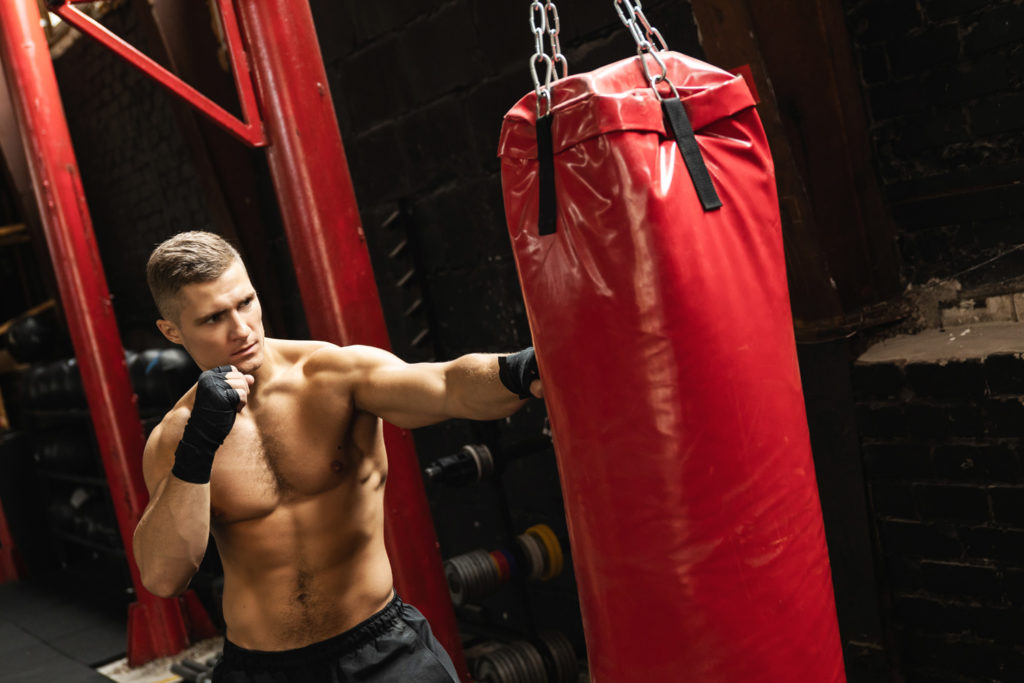
5. Karate
- Historically Rich: Originated in Okinawa, Japan, reflecting traditional values and discipline.
- Powerful and Diverse Techniques: Known for its strikes, kicks, knee and elbow strikes, and open-hand techniques.
- Holistic Approach: Focuses on self-improvement, discipline, respect, and inner strength.
Originating from Okinawa, Japan, during the Ryukyu Kingdom era, Karate is a testament to the rich tapestry of Japanese martial arts. Traditionally practiced in secret for self-defense, it is renowned for its powerful strikes, kicks, knee and elbow strikes, and open-hand techniques, reflecting deep-rooted discipline and honor.
Karate’s influence can be seen in martial arts like Muay Thai, Capoeira, and Taekwondo, sharing a particular kinship with Muay Thai due to their focus on robust strikes. Despite these similarities, Karate retains its unique essence and techniques.
Today, Karate is a journey of self-improvement, fostering discipline, respect, and inner strength. The training encompasses basic techniques (kihon), forms (kata), sparring (kumite), and self-defense. It emphasizes refining posture, balance, coordination, speed, and mental acuity, embodying both physical and spiritual growth.
6. Kung Fu
- Culturally Deep: Rooted in Chinese philosophy and military combat techniques, with a legendary origin linked to the Shaolin Temple.
- Diverse Styles: Includes Shaolin Kung Fu, Wing Chun, Tai Chi, Baguazhang, and Xingyiquan.
- More Than Physical Training: Emphasizes fluidity, quick strikes, and a philosophical pursuit of balance and self-cultivation.
Kung Fu, deeply embedded in Chinese heritage, is more than a martial art; it’s a reflection of ancient Chinese philosophy and legends. Its introduction to the Shaolin Temple marks a significant moment in its evolution, with legends tracing its roots back to an Indian monk named Damo.
Kung Fu encompasses a vibrant array of styles, each emphasizing fluidity, quick strikes, kicks, throws, and in some styles, acrobatics. The training goes beyond physical prowess, encapsulating a pursuit of balance, harmony, discipline, and self-cultivation.
The holistic training journey in Kung Fu includes mastering stances, footwork, strikes, kicks, and weaponry. It aims to refine timing, distance management, and defense while nurturing the mind, urging practitioners towards continuous physical and mental self-improvement. Kung Fu’s enduring legacy and influence are a testament to the rich history of the Chinese martial tradition.
7. Aikido
- Philosophy of Peace and Unity: Focuses on harmonizing with an opponent’s energy rather than direct confrontation.
- Fluid and Dynamic Techniques: Utilizes joint locks, throws, and pins to neutralize attackers without undue harm.
- Self-Discovery and Harmony: Training is not just about self-defense, but also personal growth and understanding.
Hailing from Japan in the 20th century, Aikido beautifully merges martial techniques with a philosophy centered on peace, unity, and personal growth. Drawing influence from Daito-ryu Aiki-jujutsu, Aikido advocates for blending with and redirecting an opponent’s energy, rather than relying on brute strength.
Practitioners, known as Aikidoka, employ fluid, circular techniques to neutralize attackers. This approach is deeply rooted in the core principles of Aikido: harmonizing with the attacker, maintaining a centered posture, and redirecting their force effectively.
Training in Aikido encompasses more than self-defense; it’s a journey of self-discovery. Aikidoka engage in roles as uke (attacker) and nage (defender), practicing kata (forms), ukemi (falling and rolling techniques), and randori (freestyle practice). Traditional weaponry like wooden swords and staffs also play a role, adding depth to this art. For practitioners, Aikido offers a path to self-understanding and harmonious connection.
8. Judo
- Practical Self-Defense and Efficiency: Integrates elements of traditional jujutsu and other martial arts.
- Leverage and Technique: Focuses on using an opponent’s energy against them through skillful throws and grappling.
- Olympic Sport and Personal Growth: Emphasizes physical conditioning, mental discipline, and mutual respect.
Judo, originating from Japan, is more than a martial art; it’s a legacy and philosophy, founded by Jigoro Kano in the late 19th century. It synthesizes traditional jujutsu with various martial arts, focusing on practical self-defense and efficiency.
At its core, Judo emphasizes strategic leverage and technique over brute force. Practitioners master throws, grappling, sweeps, reversals, counters, and combinations, aiming for maximum efficiency in movement and strength.
But Judo transcends mere technique. As an Olympic sport, it demands physical conditioning, technique repetition, dynamic randori sessions, and mental discipline. Training in Judo hones self-defense skills and fosters personal growth, instilling values of mutual respect and sportsmanship. In the dojo, the journey is as much about self-discovery as it is about learning defense.
9. Kendo
- Rooted in Tradition: Emphasizes discipline and mental focus, following the principles of Bushido.
- Precision and Technique: Focuses on swordsmanship using bamboo swords (“shinai”).
- Character Development: Goes beyond physical training to instill values of respect and humility.
Kendo, deeply ingrained in Japanese history and Bushido traditions, is a martial art centered on swordsmanship using bamboo swords, known as “shinai”. Emerging from the ancient kenjutsu, it was formally recognized as a distinct martial art in early 20th century Japan.
The essence of Kendo lies in discipline, mental focus, and character development. Practitioners learn precise strikes, thrusts, and defensive techniques, mirroring real sword combat. Beyond physical skills, Kendo cultivates respect, humility, and the embodiment of Bushido principles.
Training encompasses more than swordplay; footwork, body movement, and agility are crucial, allowing for stable and graceful movement. Kata (forms) refine techniques and strategies, while keiko (sparring sessions) provide a platform for skill application in controlled settings. Kendo is thus a journey of personal growth, physical rigor, and deep connection to Japanese warrior traditions.
10. Krav Maga
- Practical and Efficient: Designed for real-world self-defense, prioritizing swift and efficient movements.
- Diverse Techniques: Incorporates elements from various martial arts for a comprehensive defense system.
- Real-World Scenarios: Focuses on scenarios like close-quarters combat and defense against weapons.
Originating in Israel, Krav Maga is a practical martial art developed by Imi Lichtenfield in the 1930s, initially to empower Jewish communities against anti-Semitic violence. It uniquely combines techniques from diverse martial arts into an efficient self-defense system.
Krav Maga’s primary goal is rapid threat neutralization, emphasizing conditioning, endurance, and meticulous technique execution. Its training is deeply rooted in real-life scenarios, equipping practitioners for close-quarters combat and defense against weapons, including knives, sticks, and firearms. The art emphasizes targeting an opponent’s vulnerable points with strikes, punches, kicks, and elbows, underlining its effectiveness in real-world situations.
Globally recognized and respected, Krav Maga’s adoption by military and law enforcement agencies highlights its status as a formidable and adaptable martial art, tailored to contemporary challenges.
11. Wing Chun
- Tradition and Strategy: A form of Kung Fu designed for close-range combat and self-defense efficiency.
- Economy of Movement: Focuses on rapid, targeted strikes and the intelligent use of an opponent’s energy.
- Mental and Physical Training: Enhances speed, precision, anticipation, and counter-strategies.
Wing Chun, a specialized branch of Kung Fu, emerged from southern China during the Qing dynasty, surrounded by folklore. Allegedly developed by a Buddhist nun, Ng Mui, it was designed to enable smaller individuals to effectively defend against larger adversaries.
Wing Chun excels in close-range combat, combining physical techniques with a deeper philosophical approach. It emphasizes rapid, targeted strikes, focusing on an opponent’s vulnerabilities, and is distinguished by its efficient movement economy and the simultaneous execution of attack and defense.
Training in Wing Chun is as much about mental agility as physical prowess. It cultivates speed, precision, and coordination, enhancing reflexes and the ability to anticipate and counter an opponent’s moves. From rapid-fire punches to balance-disrupting low kicks, each technique reflects Wing Chun’s strategic genius, making it a martial art of resilience and empowerment.
12. Jeet Kune Do
- Fusion of Styles: Developed by Bruce Lee, combining elements from Wing Chun, boxing, fencing, and more.
- Simplicity and Efficiency: Emphasizes using the most efficient and direct techniques in combat.
- Philosophy of Growth: Fosters open-mindedness and continuous personal improvement.
Jeet Kune Do, created by Bruce Lee in the 1960s, is a martial art that embodies simplicity and directness. Translating to “the way of the intercepting fist”, it is a fusion of techniques from Wing Chun, Western boxing, fencing, Muay Thai, Taekwondo, and Kickboxing.
The philosophy of Jeet Kune Do is about more than just combat techniques; it’s about employing the most efficient and direct approach tailored to each moment. This principle minimizes unnecessary movements, allowing practitioners to maximize speed, power, and adaptability, and fluidly switch between ranges and techniques.
Training in Jeet Kune Do encompasses drills, sparring, and scenario-based exercises, all designed to develop agility, timing, and a seamless flow of actions. Beyond physical training, it instills a mindset of open-mindedness, personal growth, and a relentless pursuit of self-improvement. Jeet Kune Do is not just a fighting style; it’s a journey towards self-mastery.
13. Hapkido
- Integration of Diverse Techniques: Combines joint locks, throws, strikes, and traditional weapons.
- Principle of Energy Redirection: Uses an opponent’s momentum against them, emphasizing adaptability.
- Holistic Development: Focuses on achieving harmony between mind and body, enhancing physical and mental discipline.
Hapkido, hailing from Korea, is a comprehensive martial art that elegantly integrates various techniques, drawing inspiration from Taekwondo, Judo, and Aikido. It offers a holistic approach to self-defense, incorporating joint locks, throws, striking techniques, pressure points, and traditional weapons.
A key principle of Hapkido is redirecting an opponent’s energy. Practitioners learn to use an adversary’s momentum against them, a method that relies on adaptability and technique rather than brute strength. This approach makes Hapkido effective against opponents of varying sizes and strengths.
Choi Yong-Sool is often credited with introducing Hapkido in the mid-20th century. Under his and subsequent practitioners’ guidance, it evolved into a versatile art form. Training in Hapkido not only builds physical strength and flexibility but also focuses on mental discipline and achieving a harmonious balance between mind and body. The journey through Hapkido includes mastering structured forms, stances, footwork, and combination drills, fostering a philosophy of agility in both combat and life.
14. Capoeira
- Unique Fusion: Blends dance, acrobatics, and music, rooted in Brazilian culture and African heritage.
- Rhythmic and Fluid Movements: Characterized by strikes, kicks, sweeps, and acrobatic maneuvers.
- Cultural and Social Experience: Emphasizes camaraderie and cultural expression through music and song.
Capoeira, a distinctive martial art from Brazil, is a vibrant amalgamation of dance, acrobatics, and music, tracing its roots back to the 16th century. Developed by enslaved Africans, it combined combat techniques with dance to camouflage their training and preserve cultural ties.
The essence of Capoeira lies in its fluid, rhythmic movements. Capoeiristas perform a symphony of strikes, kicks, and acrobatic moves, imbuing their routines with evasion tactics and dynamic flips. Beyond the physicality, the acrobatic elements add flair and spectacle, distinguishing it as both an art form and a combat technique.
Training in Capoeira is an immersive cultural experience. Sessions often resemble harmonious gatherings, with capoeiristas engaging in partner drills against a backdrop of rhythmic music and songs. This not only enhances skill development but also fosters a sense of community, making Capoeira a unique blend of martial artistry, cultural celebration, and social bonding.
15. Brazilian Jiu-Jitsu (BJJ)
- Technique Over Strength: Emphasizes leveraging technique and leverage, suitable for all sizes and genders.
- Groundwork and Grappling Focus: Specializes in ground positions, joint locks, and chokeholds.
- Comprehensive Training: Combines partner drills, rolling sessions, and combat simulations for sport and self-defense.
Brazilian Jiu-Jitsu, known as BJJ, evolved from Japanese Jujutsu, influenced significantly by the Gracie family in Brazil. It champions the power of technique and leverage over brute strength, making it an effective martial art for individuals of all sizes.
BJJ’s distinct approach lies in its emphasis on groundwork and grappling. Integrating techniques like sweeps, takedowns, joint locks, and chokes, practitioners aim to gain dominant ground positions for effective control. Training in BJJ, often conducted in a traditional ‘gi’, is not limited to technique execution. It includes partner drills and realistic combat simulations, ensuring practitioners are well-versed in both sport and self-defense scenarios. With its effectiveness in MMA (mixed martial arts), BJJ is a testament to the importance of safety, skill, and strategy in martial arts.
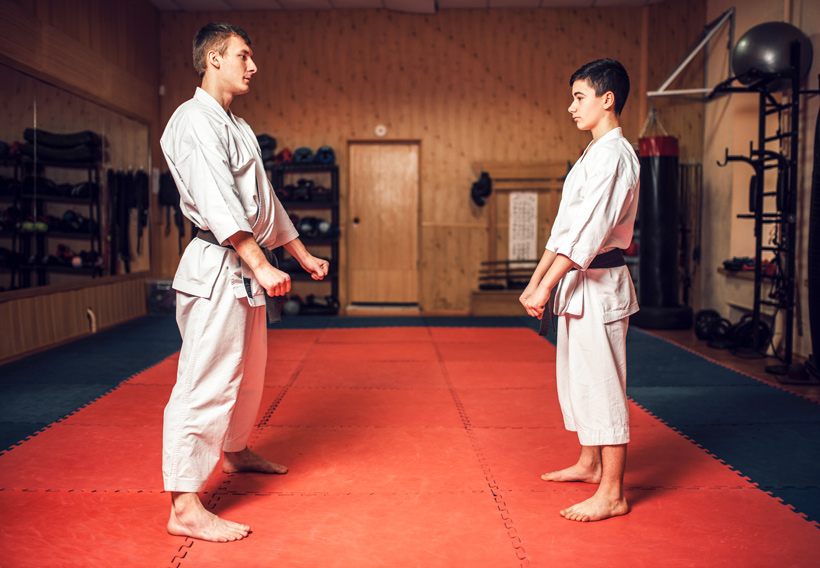
16. Jiu-Jitsu (Japanese Jujutsu)
- Leverage and Precision: Utilizes leverage, precision, and technique over force.
- Comprehensive Combat Approach: Focuses on grappling, submissions, and close-quarters combat.
- Holistic Training Experience: Includes partner drills, rolling sessions, and ‘ukemi’ (falling and rolling techniques).
Jiu-Jitsu, or Japanese Jujutsu, hails from the ancient tactics of samurai warriors. This martial art is centered on grappling, submissions, and efficient self-defense in both standing and ground scenarios. It empowers practitioners, regardless of size, to effectively handle larger adversaries by redirecting their force.
Training in Jiu-Jitsu is a holistic experience, blending partner drills with rolling sessions and the crucial practice of ‘ukemi’—the art of falling and rolling safely. This martial art encompasses a diverse range of techniques, including throws, joint locks, pins, and strangleholds. It caters to both experienced martial artists and beginners, offering a deep dive into the synergy of mind, body, and technique, and showcasing the rich history and versatility of traditional Japanese martial arts.
17. Ninjutsu
- Diverse Martial Art Techniques: Incorporates striking, grappling, throwing, and joint locking.
- Weapon Proficiency: Ninjas are skilled in various weapons like swords and shurikens.
- Stealth and Mental Discipline: Focuses on blending with the environment and employing stealthy tactics.
Ninjutsu, a unique style of Japanese martial arts, was historically developed and practiced by ninjas. It is characterized by a diverse combination of martial techniques, including striking, grappling, throwing, and joint locking.
Ninjas are known for their skill in using various weapons such as swords, shurikens (throwing stars), and rope darts. Ninjutsu training is not limited to physical combat techniques; it also includes meditation to enhance focus and mental discipline. Endurance exercises form a part of the regimen, building physical strength and stamina. The essence of Ninjutsu lies in blending with the environment, employing stealth, and utilizing deception to gain an advantage over opponents, embodying the cunning and adaptability of the traditional ninja.
18. Escrima
- Filipino Martial Art: Known for its practical and efficient combat techniques.
- Versatile Weaponry and Hand-to-Hand Skills: Teaches both armed and unarmed combat skills.
- Real-World Application: Emphasizes practicality in various situations, enhancing agility and alertness.
Escrima, originating from the Philippines, is a martial art that stands as a testament to Filipino combat prowess. Known locally as Arnis or Kali, Escrima encompasses a comprehensive range of techniques, from effective stick and blade handling to an intricate blend of strikes, blocks, joint locks, and throws.
Its training emphasizes practicality and efficiency, making it highly applicable in real-world scenarios, including close-quarter combat and weapon disarms. Whether armed or unarmed, Escrima equips practitioners with a versatile skill set suitable for various self-defense situations. Training in Escrima not only hones combat skills but also sharpens hand-eye coordination, enhancing agility and alertness in daily life. It’s a martial art that offers more than just fighting techniques; it’s a discipline that cultivates practicality, responsiveness, and adaptability.
How to Choose the Right Martial Art to Learn
Choosing the right martial art to learn can be a daunting task with so many options available. Here are some factors to consider when making your decision. First, think about your goals and what you want to achieve through learning martial arts.
Do you want to focus on self-defense, physical fitness, or personal development? Understanding your motivations will help narrow down the choices. Second, consider your physical abilities and limitations.
Some martial arts styles place more emphasis on strength and power, while others focus on agility and flexibility. Choose a style that aligns with your natural strengths or one that challenges you in areas where you want to improve.
Third, research the different styles and their training methods. Each martial art has its unique techniques and approaches to combat or self-defense. Find a style that resonates with you and matches your preferred learning style – whether it’s striking techniques like punches and kicks or grappling techniques like throws and submissions.
Finally, try out different classes or schools before committing to one style. Many places offer trial sessions or introductory packages that allow beginners to experience the training firsthand.
This way, you can get a feel for the instructor’s teaching style, the atmosphere of the class, and see if it’s something you enjoy.
Remember: It’s important not only to choose a martial art but also find an instructor who is knowledgeable, experienced, patient (especially for beginners), and creates a safe environment for training.
Keep these considerations in mind when choosing the right martial art for yourself – understanding your goals, assessing your physical abilities, researching different styles, and trying out classes – as they will guide you towards finding an art form that suits both your interests and capabilities.
Read also:
- Top 21 Deadliest Martial Arts In The World According To Experts
- 13 Best Martial Arts For Self-Defense
- Best Martial Arts For Streetfight
FAQs
1. What are some different types of martial arts?
Some different types of martial arts include karate, taekwondo, judo, and jiu-jitsu.
2. Which martial art is best for self-defense?
Krav Maga is often considered one of the most effective martial arts for self-defense as it focuses on practical techniques for real-life situations.
3. Can children learn martial arts?
Yes, many martial arts schools offer classes specifically designed for children to learn self-discipline, respect, and basic self-defense skills.
4. How do I choose the right type of martial art to learn?
When choosing a martial art to learn, consider factors such as your fitness level, goals (self-defense or competition), location availability, and personal preferences in terms of striking versus grappling techniques.
5. Can an adult still learn martial arts?
Definitely! Age is no barrier to learning martial arts. Whether you’re a beginner or revisiting a childhood passion, martial arts offer adaptability to different fitness levels, skill sets, and objectives. Instructors are skilled at customizing training to individual capabilities, prioritizing safety and enjoyment.
For adults, engaging in martial arts provides numerous benefits, including physical conditioning, self-defense proficiency, stress reduction, and overall personal growth.
Conclusion
In conclusion, martial arts offer a wide range of styles and techniques for self-defense, fitness, and personal growth. From the powerful strikes of Muay Thai to the graceful movements of Tai Chi, there is something for everyone.
Whether you want to compete or simply improve your physical and mental well-being, exploring different types of martial arts can be a rewarding journey filled with discipline, respect, and lifelong learning.

